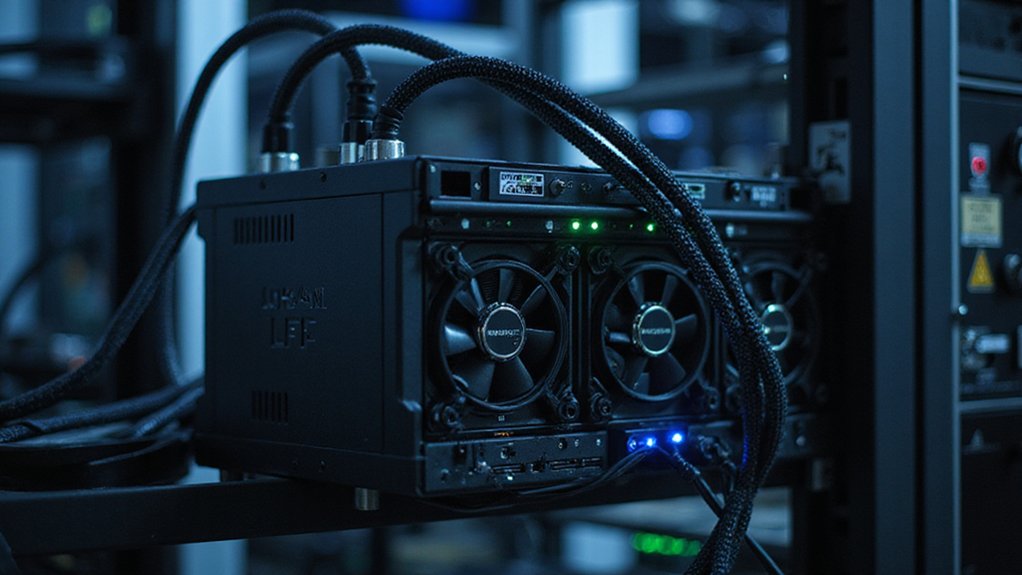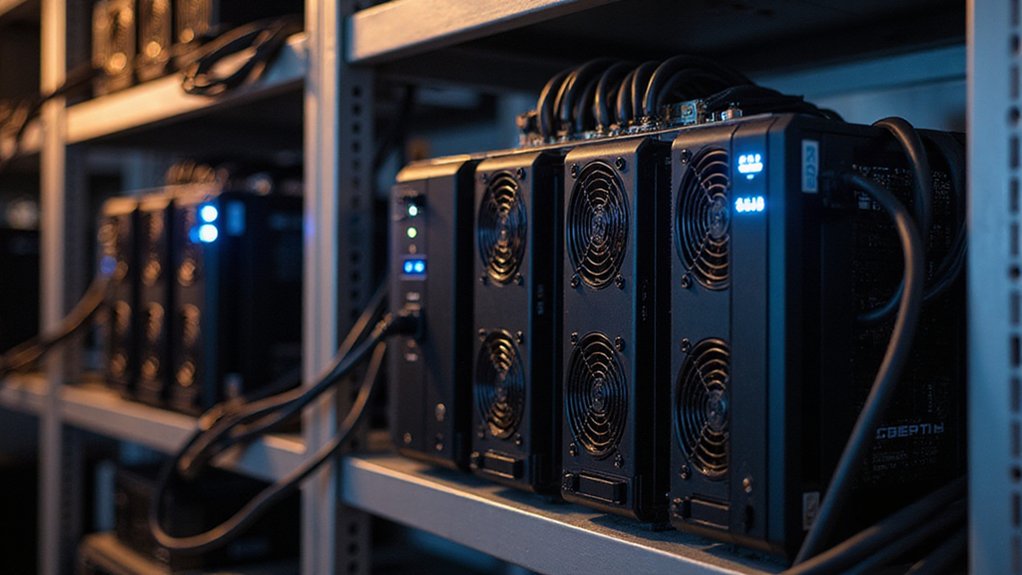CGMiner represents open-source cryptocurrency mining software that transforms computing hardware into Bitcoin-generating machines through command-line efficiency rather than user-friendly interfaces. This C-language program connects miners to blockchain networks via Stratum protocol, manages ASIC and GPU hardware with surgical precision, and monitors temperatures while adjusting fan speeds to prevent expensive equipment meltdowns. Its enduring dominance since 2011 reflects the mining community’s preference for substance over style—though mastering its technical capabilities reveals why casual miners often seek more accessible alternatives.

The cryptocurrency mining landscape—a domain where computational power translates directly into digital currency—has long been dominated by specialized software that can extract maximum performance from increasingly sophisticated hardware. Among these tools, CGMiner stands as perhaps the most enduring illustration of open-source efficiency, written primarily in C and maintained by a community that apparently never sleeps (or perhaps profits handsomely from their sleeplessness).
This command-line behemoth originally emerged from the AMD GPU ecosystem but has since expanded its reach with the diplomatic flexibility of a Swiss banker, now supporting ASICs, FPGAs, and multiple operating systems including Windows, Linux, and macOS. The software’s open-source nature provides the transparency that miners crave—after all, when your electricity bill resembles a small nation’s GDP, you want to know exactly what your hardware is doing.
CGMiner’s functionality revolves around the Stratum protocol, which distributes computational tasks with algorithmic precision while maintaining continuous updates between mining pools and individual rigs. The software supports device hotplugging, remote interface access, and RPC API integration—features that transform chaotic mining operations into something resembling organized chaos. While CGMiner excels in technical sophistication, users seeking graphical interfaces often prefer alternatives like EasyMiner for its user-friendly dashboard and real-time mining statistics.
The intensity settings, ranging from 0 to 20, allow users to balance performance against the ever-present risk of hardware failure. Too aggressive, and your expensive ASIC becomes an overpriced paperweight; too conservative, and profitability evaporates faster than venture capital during a bear market. The software’s dynamic intensity adjustment attempts to solve this Goldilocks problem automatically, though experienced miners typically prefer manual control.
Despite its popularity across Bitcoin, Litecoin, and Dogecoin mining communities, CGMiner remains stubbornly command-line based, effectively filtering out casual users who expect graphical interfaces. This design philosophy—whether intentional gatekeeping or pragmatic efficiency—ensures that only those comfortable with terminal commands need apply. The software features a fixed commission structure with no hidden fees, providing transparent cost management for mining operations.
The software’s binary kernel loading and internal mini-database for block detection demonstrate the engineering sophistication required in modern mining operations. Beyond performance optimization, CGMiner incorporates comprehensive temperature monitoring capabilities that automatically adjust fan speeds and can trigger emergency shutdowns when critical thermal thresholds are exceeded. CGMiner’s continued dominance suggests that in cryptocurrency mining, as in many financial endeavors, substance ultimately trumps style—though substantial electricity costs remain non-negotiable regardless of software choice.
Frequently Asked Questions
Is CGMINER Compatible With Windows, Mac, and Linux Operating Systems?
CGMiner demonstrates remarkable cross-platform versatility, operating seamlessly across Windows, macOS, and Linux environments through its C-based architecture.
While Windows users enjoy prebuilt executables and Linux enthusiasts leverage open-source customization capabilities, macOS miners—despite representing a smaller demographic—access identical functionality.
The command-line interface remains consistent across platforms, though hardware driver availability and performance optimization vary by operating system, creating subtle disparities in mining efficiency and setup complexity.
How Much Electricity Does CGMINER Consume During Cryptocurrency Mining Operations?
CGMiner itself consumes negligible electricity—the software merely orchestrates the hardware symphony.
The actual power consumption depends entirely on the mining rigs it manages, ranging from modest GPU setups drawing several hundred watts to industrial ASIC farms consuming megawatts.
A typical CGMiner-controlled operation might consume 1,000-3,000 watts per rig, translating to $100-400 monthly electricity costs at residential rates (though serious miners wisely secure cheaper industrial pricing).
Can CGMINER Mine Multiple Cryptocurrencies Simultaneously on the Same Hardware?
CGMiner cannot mine multiple cryptocurrencies simultaneously on identical hardware—a limitation stemming from algorithm-specific operational requirements rather than software deficiency.
ASICs remain locked to particular algorithms (SHA-256 for Bitcoin, Scrypt for Litecoin), while FPGAs, despite their reprogrammable nature, require separate configurations for different coins.
Users seeking multi-coin mining must run multiple CGMiner instances with dedicated hardware for each cryptocurrency, assuming adequate system resources and power capacity exist.
What Are the Minimum Hardware Requirements to Run CGMINER Effectively?
CGMiner demands surprisingly modest specifications—2GB RAM and dual-core processing suffice for basic operations.
However, mining effectiveness hinges on peripheral hardware: OpenCL-compatible GPUs (preferably AMD ATI for Scrypt currencies), ASIC miners for Bitcoin’s computational brutality, and robust USB hubs delivering stable power to multiple devices.
Wired Ethernet connections prevent the peculiar irony of losing cryptocurrency to internet hiccups, while adequate cooling systems maintain hardware stability during marathon mining sessions.
Does CGMINER Support GPU Mining or Only ASIC and FPGA Devices?
CGMiner has effectively abandoned its GPU mining roots, having shifted from AMD GPU optimization to exclusively supporting ASIC and FPGA devices.
While earlier versions championed scrypt-based GPU mining for altcoins, modern releases deliberately exclude GPU functionality—a strategic pivot reflecting ASICs’ computational dominance.
GPU miners seeking current support must resort to specialized alternatives or antiquated CGMiner versions, though such archaeological approaches hardly constitute sound mining strategy in today’s efficiency-driven landscape.









